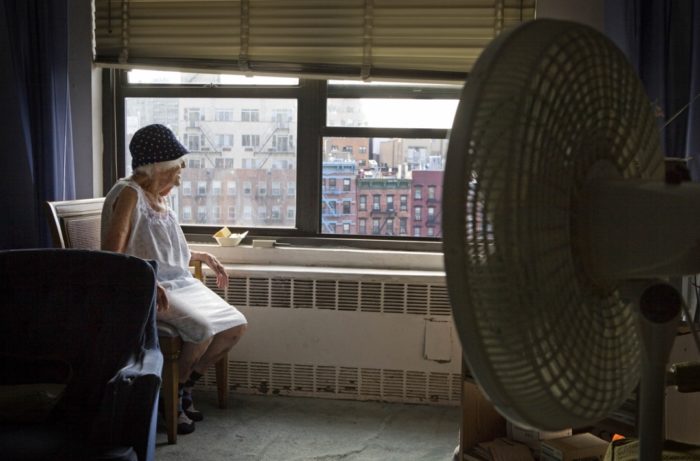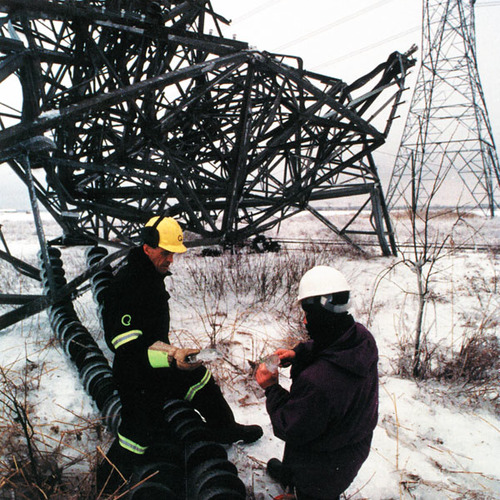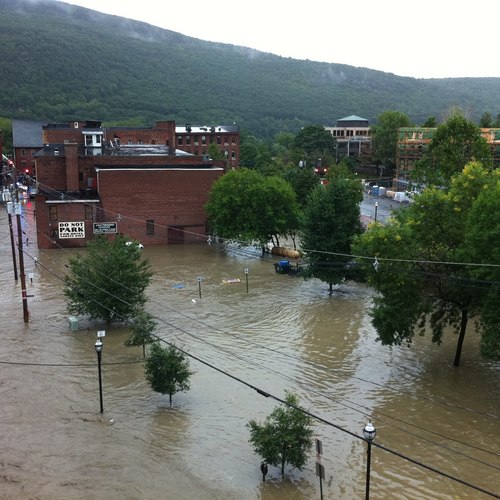Image Credit: David Goodman - from the Buildings Resiliency Task Force Report
Image Credit: David Goodman - from the Buildings Resiliency Task Force Report Find the superinsulated row house in this Brooklyn streetscape. This thermographic image shows very little heat loss from one house, which will maintain habitable temperatures during a long-term power outage.
Image Credit: Sam McAfee, sgBuild.com - from the Buildings Resiliency Task Force Report Our first take at defining habitable temperatures (°F) in buildings that lose power or heating fuel. Click to enlarge.
Image Credit: Resilient Design Institute (unpublished)
Over the past five months, the New York City Buildings Resiliency Task Force has been working to figure out how to make buildings in the City more resilient. The Task Force, which was created at the request of Mayor Michael Bloomberg and City Council Speaker Christine Quinn in the wake of Superstorm Sandy and facilitated by Urban Green, the U.S. Green Building Council Chapter in New York City, issued its recommendations on June 13, 2013.
The task force included about 200 people organized into four building-type committees (Commercial Buildings, Multi-family Residential Buildings, Critical Buildings, and 1-, 2- and 3-Family Homes) and three working groups (Structure, Façade, and Interiors; Electrical and IT; along with HVACR, Plumbing and Fire Protection). I participated in several meetings as an at-large member of the task force.
The findings were presented in a 40-page Summary Report as well as a much longer, 185-page document that includes detail on each of the 33 proposals being presented to the City. It is important to note that these are advisory recommendations only; there is no guarantee that any will be acted on.
Some buildings lack running water when the power goes out
The report includes five types of recommendations based on suggested implementation: Required Actions, which would be mandated as retrofits for existing buildings (there are very few of these); New Code measures that would be incorporated into codes for new buildings and major remodeling projects; measures that would Remove Barriers to creating more resilient buildings; Recommended Practices; and measures that require Further Action.
These 33 proposals range from providing access to potable water in multifamily residential buildings at a level in the buildings where municipal pressure will deliver the water (so that residents on upper floors will have access if pumps in the building are inoperable), preventing sewage backflow into basements (a huge problem with Sandy), ensuring operability of toilets and sinks during power failures; eliminating existing barriers to elevating buildings above flood levels, capturing stormwater to reduce flooding, providing quick connections to temporary (mobile) generators and boilers, and requiring operable windows.
Maintaining habitable interior conditions in the event of lost power
The measure that I’m most excited about in the task force report is a proposal to Maintain Habitable Temperatures Without Power. This has been a key tenet of the “resilient design” agenda I’ve been advancing through the Resilient Design Institute (RDI) and the concept of “passive survivability” that I’ve been pushing for since late 2005, following Hurricane Katrina in the Gulf Coast.
When power was lost in parts of New York City — in some places for several weeks — there was recognition by the City that conditions could get pretty dire very quickly, especially in high-rise residential buildings during hot weather (projected to become a more common occurrence). In the summer, temperatures may rise quickly to dangerous levels, and in the winter, temperatures will fall. We can refer to these as drift temperatures.
This is a big issue in New York City, which houses a remarkable 11% of the nation’s occupants of high-rise apartment buildings. There is clear recognition that evacuating millions of residents due to a weather event — or something else — that knocks out power for an extended period of time. With a population of 8.3 million, there simply isn’t a way to carry out a widespread evacuation; there has to be a way for residents to shelter in place.
What defines habitable temperatures
This brings me to one of the early focus areas of RDI: defining what constitutes habitable or livable conditions. In May of this year, RDI sponsored an all-day retreat of leading energy engineers, architects, planners, and public health experts to brainstorm metrics of resilience, including temperature and humidity. In follow-up to this Benchmarking Resilience retreat, a meeting participant and colleague, Seth Holmes, AIA, of the University of Hartford, will be taking the lead with a more in-depth literature review and expert interviews. We are hoping to produce a peer-reviewed technical paper on these issues in the fall.
There are a lot of factors that come into play with the question of habitable conditions, including humidity (with higher humidity, moisture doesn’t evaporate as easily from our skin and we suffer more from the heat), duration (putting up with no air conditioning for one day is one thing, putting up with it for a week or two is very different), and perhaps regional adaptation.
Before the availability of air-conditioning, it was a pretty reasonable assumption that people in the South could deal with heat better than us northerners, but that may not be the case as much today. In fact, some suggest that those of us up north may now be better adapted to hot, humid weather than our southern neighbors, because we aren’t always in air conditioned spaces. My guess is that we’ll end up with something like 90°F, with some correction for relative humidity as a reasonable upper boundary for habitability (see the matrix reproduced as Image #3, below).
At the low-end of the livable temperature range, perhaps the argument for regional adaptation is stronger. My sense is that 50°F to 55°F is a reasonable lower boundary for livable conditions — perhaps 50°F for more northern climates and 55°F for southern locations, where the blood is thinner.
This matrix is just a starting point. I would welcome input and references to technical publications that define habitable temperatures. Are these temperatures reasonable?
Buildings that maintain habitable conditions
Once we determine what a reasonable temperature range is for habitability — not comfort, mind you, but survivability — we can figure out what building design measures are needed to achieve those drift temperatures. And we should be able to model that performance using fairly standard energy modeling software.
Really well-insulated buildings will maintain the habitable conditions much longer than conventional buildings — perhaps even indefinitely. A home built to the Passivhaus standard (a rating system for ultra-low-energy buildings that emerged in Germany and is gaining popularity here) incorporates not only very high insulation levels, super-high-performance windows, and very low air leakage, but also some passive solar gain.
In most places, such a home will never drop below 55°F or perhaps even 60°F in winter, even with no supplemental heat. And in the summer, if such a house is wisely operated (closing windows during the day, for example), it should maintain temperatures significantly cooler than outdoors.
Moving ahead with this work
The Buildings Resiliency Task Force in New York City listed the proposal on maintaining habitable temperatures during power outages as a measure needing further action. Urban Green is hoping that the work of the task force can be continued into the fall to provide more detailed guidance on this and a number of other proposals.
If that extension is approved, I’m hoping that RDI will be able to provide detailed guidance, both on the metrics and on achieving such performance in buildings. We are still seeking foundation grants to support this work — so let me know if you have suggestions of foundations, corporations, or agencies that might want to support this work.
Alex is founder of BuildingGreen, Inc. and executive editor of Environmental Building News. In 2012 he founded the Resilient Design Institute. To keep up with Alex’s latest articles and musings, you can sign up for his Twitter feed.
Weekly Newsletter
Get building science and energy efficiency advice, plus special offers, in your inbox.
















6 Comments
This is an interesting topic
I think 50-55 is a reasonable lower boundary, though extra precautions would be necessary for infants and the elderly.
I occasionally have the "pleasure" of working in very hot / humid conditions, and there is a certain amount of adaptation that goes on - I become less miserable as the work goes on, FWIW.
Air movement during a heat event is crucial - the difference even a small fan makes is astounding. We have a wide variety of portable fans and blowers for jobsites.
In NYC high rises, it occurs to me that elevator shafts represent a huge opportunity to foster natural ventilation during an extended outage. A means would be needed to open the top of the shaft to the sky and then partially open elevator doors at each floor. There would have to be fall protection at each opened elevator door, perhaps in the form of a removable railing that is installed and locked into place by the building super.
Each apartment dweller could open windows and air would flow through units, into atriums and up the shaft.
It would be interesting to test the concept. I know it works in two+ story homes.
The temperature / humidity table is interesting, but one would have to consider occupied conditions, especially in any crowded shelter scenario - witness conditions post-Katrina in New Orleans superdome and hospitals. 90*F might be acceptable with air movement and humidity at 50%, but neither condition obtains for long in a shelter.
"a key tenant"
Sorry, my inner copy editor will not keep quiet. Let's make that 'tenet'.
Response to James Morgan
James,
Thanks again for your help. The change has been made.
Glad that wasn't
my error!
Alex, you're pretty close.
Alex, you're pretty close. The incidence of heat exhaustion and heat stroke rise dramatically once people are exposed to 90° F and higher temperatures. However how well people are able to respond has a lot to do with their individual health, for example people with high blood pressure and/or diabetes have damage to their capillary beds , which results in decreased peripheral blood flow. This damage in effect decreases the size of the body's radiators, as well as making them less effective. Because of this I strongly recommend that any system that is put in place identifies at risk individuals and has a plan in place on how to deal with them. This system should include education (written materials in their native language at an appropriate reading level, as well as verbal education, etc...), a robust system to check on at risk persons (buddy system, frequent checks by multiple people, contact points with local agencies for dealing with urgent and emergency situations, etc...), a plan to get water and electrolytes to all building inhabitants, and a plan to ensure that at risk persons are able to take extra showers or baths, have water and spray bottle misters as well as fans, and are aware of other strategies to cool down. (http://www.ncbi.nlm.nih.gov/pubmed/17698676)
Ventilation
The survivability specifications seem to require good insulation values. Those values would be to some degree short circuited by natural ventilation.
I'm making the assumption that the improved insulation levels would be accompanied by appropriate air sealing. In this case ventilating through unit or floor HRVs running on ECM motors would maintain the temps in the design range.
How about a stationary bike powering the low consumption HRVs per floor
I'm only half joking. Just a little bit of energy could keep those with marginal health in a safe range.
Log in or create an account to post a comment.
Sign up Log in